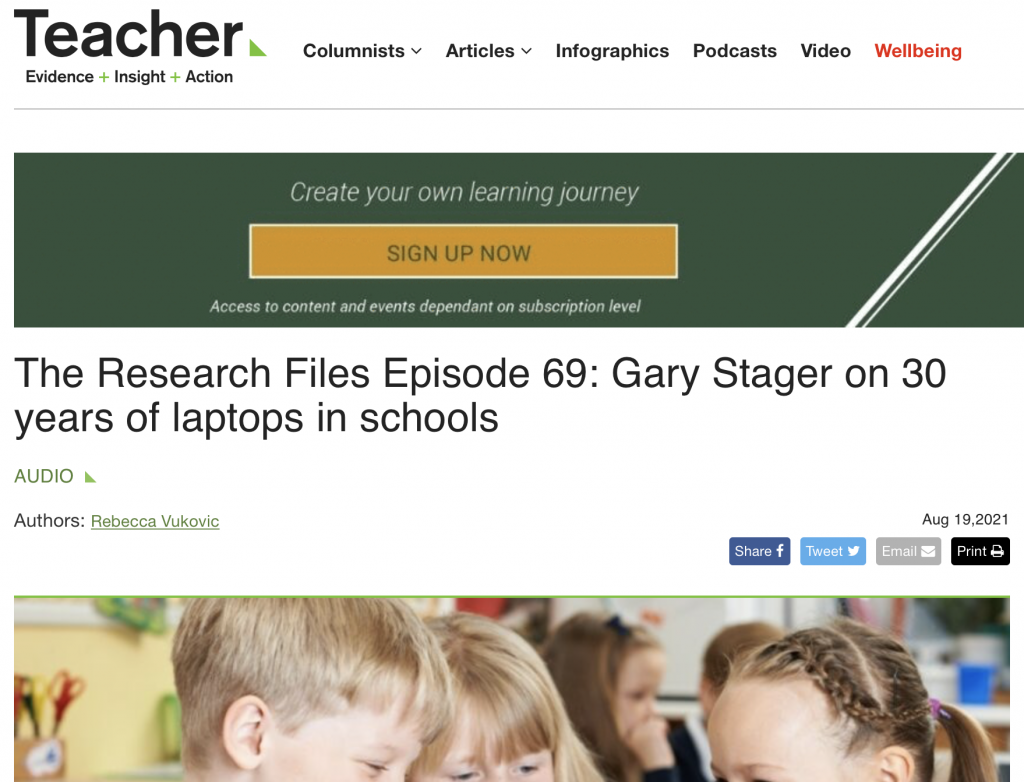
In July 1990, I made my first trip to Australia to speak at the World Conference on Computers in Education, held at what was then the new Darling Harbor Convention Centre. Not only did this represent the realization of a childhood dream of visiting Downunder, but the conference brought together US “Logo legends,” including Seymour Papert, Alan Kay, Brian Silverman, Steve Ocko, and Mitchel Resnick with remarkable Logo-using educators from Australia and around the world. Upon arrival in Sydney, I was transported to a large multi-day joyfully chaotic Logo and robotics pre-conference workshop. The workshop participants were teachers and kids from schools in which everyone had a personal laptop computer. I had a ball and collaborated with some Aussie kids to build a working fax machine out of LEGO. This trip would be the start of something big – a longterm love affair with Australia, lifelong friendships, and countless professional adventures across that continent. I even earned my Ph.D. at The University of Melbourne.
During WCCE, I was invited to return to Australia to lead professional development activities at what were the first two schools in the world to commit to universal personal computing. In other words, every student would have their own laptop computer to be used across the curriculum. Best of all, the schools embraced Papert’s learning theory of constructionism and the progressive education practices required to nurture constructionist learning. At the time, I didn’t know any adults in the US who had their own laptop, but here I was in a strange land helping children invent the future of education. I surely learned more than I taught, but remain incredibly grateful for the opportunities afforded me to show the world that things need not be as they seem. The faith and trust invested in me by David Loader, arguably the world’s most accomplished school principal, continues to blow my mind.
Two Australian schools began the 1:1 revolution
Victoria’s (private) Methodist Ladies’ College (MLC) has been fairly well documented, but the pioneering work of the other school, Queensland’s (public) Coombabah State School, has been quickly fading from memory. I’ve done my best to preserve, curate, and share as much of the work documenting the early days of 1:1 computing in schools (with more left to locate), but evidence from Coombabah has been scarce. A great book was even written about the MLC 1:1 efforts. Coombabah was significant because it was the site of the first 1:1 personal computing a co-ed public school. At the time, the State of Queensland was talking about every child in the state having their own laptop by 1991.
What happened in Australia more than thirty years ago matters because we stand on the shoulders of giants and because there remains no universal adoption of personal computing for children. This ongoing controversy demonstrates a lack of consensus behind empowering children.
“Girls’ School Leads Laptop Revolution”
THE AGE (NEWSPAPER) – 1993
I knew that at least two books of scholarship about the Coombabah 1:1 experience were published by the Australian Council for Educational Research, but books had gone out-of-print. After several years of email, begging, and pleading, a lovely woman at ACER, Pru Mitchell, scanned the two books I was aware of, plus another, and made them available. These three recently uncovered texts, along with seminal articles, and the book MLC published about their approach to 1:1 computing may be found here.

Recently, Australia’s Teacher Magazine interviewed me for a podcast and dusted away the cobwebs to remember the magical early days of 1:1 computing in schools. The audio podcast and transcript may be found here.
Resources
Learn more about the powerful ideas behind laptops in education and the early days of 1:1 computing here and here. (lots of links)
Postscript
The passage of time is cruel to history. Countless memos, newsletters, papers, and student projects from the early days of 1:1 computing are lost, perhaps forever. One of the world’s leading PR firms took thousands of photos, just three decades ago. None can be found. Cherish, curate, and maintain your memories for future generations to enjoy and learn from!
Veteran educator Gary Stager, Ph.D. is the author of Twenty Things to Do with a Computer – Forward 50, co-author of Invent To Learn — Making, Tinkering, and Engineering in the Classroom, publisher at Constructing Modern Knowledge Press, and the founder of the Constructing Modern Knowledge summer institute. He led professional development in the world’s first 1:1 laptop schools thirty years ago and designed one of the oldest online graduate school programs. Gary is also the curator of The Seymour Papert archives at DailyPapert.com. Learn more about Gary here.

